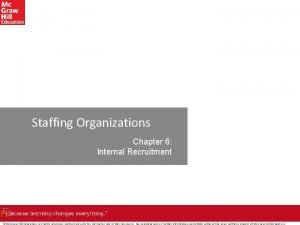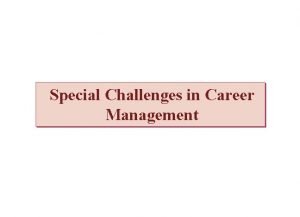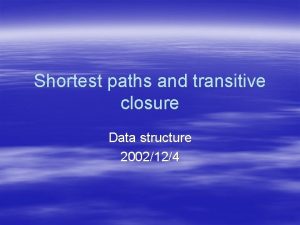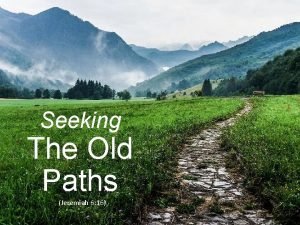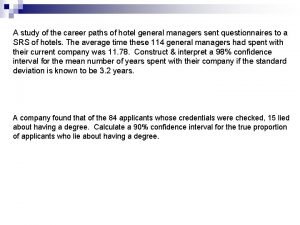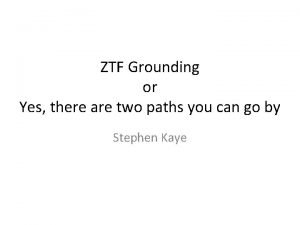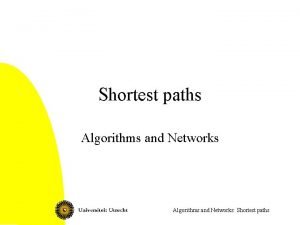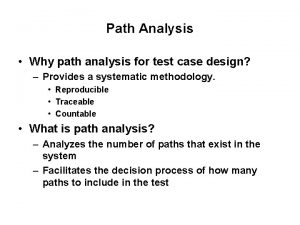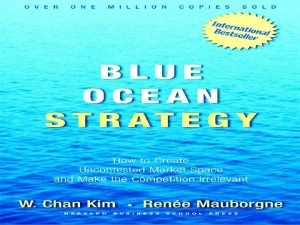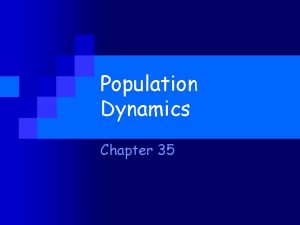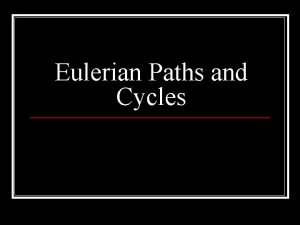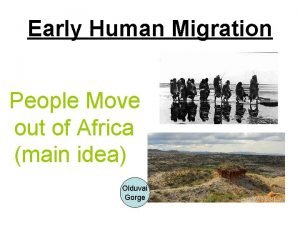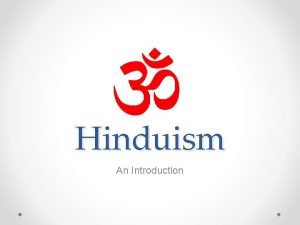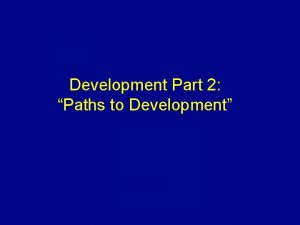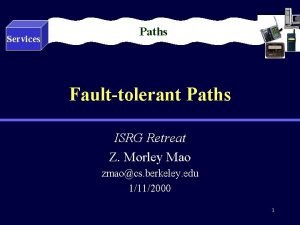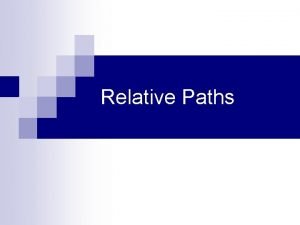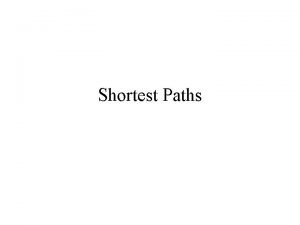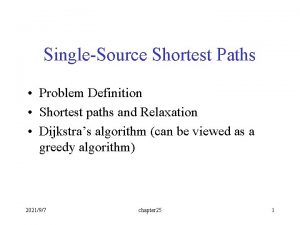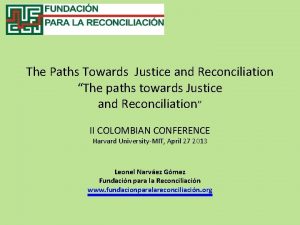Development Part 2 Paths to Development What is




















































- Slides: 52

Development Part 2: “Paths to Development”

What is Development? • Reread/review prior information (Part 1) • Criticisms of the “development” concept (#5) – One single path/trajectory toward development? • Is “industrialization” always necessary? • Have commodity chains broken the link between industrialization and increasing prosperity? – See article on website “Arrested Development” – Western bias (values materialism, is industry good? ) – discounts international influence • Countries don’t operate in a vacuum • See Wallerstein’s World System’s Theory • See p 464 – 465 for alternative discussion – Bhutan measures Gross National Happiness (GNH) based on psychological well-being, time use, community vitality, culture, health, education, environmental diversity, living standard and governance. • Don’t confuse with criticisms of GDP/GNI – Informal economy, inequality, neg. externalities (pollution)

Paths to Development? • International Trade Model/Rostow’s model of development – Five stages • Traditional society – – subsistence agriculture govt. funds spent on military/religion Rigid social structure (example: female subservience) technology slow to change

Paths to Development? • International Trade Model/Rostow’s model of development – Five stages • Traditional society • Preconditions to “take-off” – elite, well-educated (usually in West) take lead – identify assets to exploit (raw material, cheap labor, etc. ) – investment in new technology and infrastructure (transportation, clean water systems, etc. ) – hope to stimulate PRODUCTVITY

Paths to Development? • International Trade Model/Rostow’s model of development – Five stages • Traditional society • Preconditions to “take-off” • Takeoff – rapid growth in limited industries » Example? » Textiles – these industries achieve technological advances and become productive – “Industrial Revolution”, growth takes hold, urbanization increases, tech and mass production breakthroughs

Paths to Development? • International Trade Model/Rostow’s model of development – Five stages • • Traditional society Preconditions to “take-off” Takeoff Drive to Maturity – – – technology diffuses from initial industries Workers become more skilled and specialized International trade increases Modernization Population growth slows

Paths to Development? • International Trade Model/Rostow’s model of development – Five stages • • • Traditional society Preconditions to “take-off” Takeoff Drive to Maturity Age of Mass Consumption – shift from heavy industry to consumer goods – High incomes, wide spread production of consumer goods – Majority of workers enter service sector jobs


Paths to Development? • International Trade Model/Rostow’s model of development • Five stages • Why optimistic? – Eastern/Southern European growth, Japan – LDCs have tons of resources to exploit – Examples of international trade approach • The “Four Asian Dragons” or “Four Asian Tigers” – Taiwan, Singapore, South Korea, Hong Kong – “Baby Tigers” , “Tiger Cubs” trying to follow pattern » Malaysia, Thailand, Vietnam, Indonesia, Philippines • Petroleum-rich Arabian Peninsula states • Current example? – See “Ghana” article on website for how the International Trade Model works in real life.


Paths to Development? • International Trade Model – Problems/criticisms (#11 diff. from text) • single commodity – depends on world price (cocoa in Ghana, oil in Venezuela) » could lead to loan default if price collapses – therefore, commodities are often leased/controlled by outsiders (MDC corps) who keep lion’s share of profits » development (technology, skills, etc. ) doesn’t diffuse to people as a whole but only to those connected to foreign investors • with reliance on cash crops must buy food – hunger, less money for investment • income inequality – result of both this model & structural reform programs (later)

Paths to Development • self-sufficiency model – Characteristics: • Barriers are established to protect local businesses – Three most common barriers = (1) tariffs (tax on imported goods), (2) quotas, and (3) restricting # of importers – “protectionism”

Tariffs • Review impact of tariffs from class notes

Paths to Development • self-sufficiency model – Characteristics: • Barriers are established to protect local businesses – Three most common barriers = (1) tariffs (tax on imported goods), (2) quotas, and (3) restricting # of importers – “protectionism” • Distribution/pace of development = even but low – Investment spread across economy – Goal is to develop national industries and – reduce poverty over consumerism • Two major problems with this approach: – Inefficient businesses are protected – A large bureaucracy is needed to regulate/monitor barriers » costly » could lead to corruption » growth of black market

Self-sufficiency vs. Int’l trade approach • International trade approach triumphs – Countries switch because evidence indicates that international trade is the more effective path toward overall development – Example: India

Self-sufficiency vs. Int’l trade approach • International trade approach triumphs – made easier by globalization – “Neo-liberalism” • Dominant economic/political theory by end of 20 th c. • Reduce government intervention in markets • Favored by: – Multinational corps. , Big Business, Wall St. = Republicans – Bill Clinton, Pres. Obama, Rahm Emanuel = Democrats » NAFTA, TPP (Trans-Pacific Partnership) • Global economic power shifts from states to corps. – WTO (World Trade Org. ) = referee on global trade • Enforces trade agreements – Helps reduce trade barriers = “free trade” – Allows for non-penalized retaliation or fines. • Eliminate restrictions on the movement of $ • Criticisms: – Left = anti-democratic, favors wealthy corps. , ignores the poor – Right = national sovereignty is violated (see TPP)


Rostow’s “modernization”, “ladder of development” or “int’l trade” approach to development Losers Winners • Multinational corporations – Low wages, higher profits, higher stock prices – Stockholders, investors • In LDCs – People/regions connected to int’l trade or the “core” • Consumers – Lower prices • BIG Q? Will low prices continue to offset wage stagnation? • Low skill workers (MDCs) – Highly paid union workers in manufacturing • Unconnected LDC • Small businesses/domestic manufacturing • Prices are undercut • Downward wage pressure – Will wages decr. or stagnate for skilled workers as well? • Govt. workers privatized • can tertiary jobs be outsourced, automated, globalized?

Sustainable Development


What is Sustainable Development? • achieving human development goals while at the same time conserving natural systems and… – Conservation • use of resources to meet human needs while maintaining them for use by future generations. – Preservation • Keep resources in their present condition. Don’t touch! (nat’l parks) • meeting the needs of the present without compromising the ability of the future generation. But the dilemma… • Econ. growth/wealth ↗ consumption (depletion) ↗ pollution ↗ • WWF says we are overcapacity in use of resources – How would you classify this point of view? • Neo-Malthusian • Others say, “resources” can be redefined – How would classify this point of view? • Environmental possibilism/anti-Malthusian • What types of resources do we worry most about depleting?

Energy Consumption • Usage is split 50/50 between MDC and LDCs – But per capita usage in 3 x higher in MDCs • MDCs must import supplies from LDCs to meet needs – LDCs using more due to development, causing price ↑ • China is expected to be the world’s biggest energy user by 2015 • As LDCs develop , we must find ways to fuel their growth (hopefully clean)

Non-renewable Energy – 5/6 ths of world’s energy supply from 3 main sources: • fossil fuels = coal, natural gas, and oil • Enhanced extraction = fracking = polluting water, earthquakes – Local/personal goal = reduce “carbon” footprint

Renewable Energy (sustainable? ) – Biomass = wood/ethanol/sugar cane • sometimes more energy to grow crops than energy produced • deforestation, reduction in soil fertility – Geothermal energy (energy from the Earth’s interior) • most accessible near fault lines, volcanic areas – Hydroelectric power • 2 nd largest source of electricity after coal • Three Gorges Dam (China) = environmental disaster – Nuclear energy • high cost to build, radioactive wastes, accidents are catastrophic! – Chernobyl, Fukushima – Solar energy • intermittent (not consistent). Storage? Need batteries = expensive • recently cost = nonrenewable energy in certain areas = grid parity – Incr. efficiency, Chinese manufacturing/government support – Wind power • noisy, lethal to birds and bats, visual blight

Other major depletable resource? • Water



Aral Sea (USSR diverts water for irrigation)

Sustainability Question? How do we reduce pollution? (to leave a cleaner Earth for future generations) • Recycling (pollution control starts at home) – “Think globally, Act locally” • Reduce throwaway/non-biodegradable packaging • No more styrofoam • “cap and trade” or “emissions trading” • uses a market concept • polluters given allowances to pollute by a govt. agency – Markets formed to buy unused allowances from those who don’t use them – Sold to those who wish to pollute more than their allowance. – Industries most able and willing to reduce pollution will do so and profit from their surplus credits • Therefore, pollution reduction is incentivized! – it rewards companies to pollute less – Increases costs/punishes those who pollute more


Paris Agreement (2016) • Limit global warming to 2° C (w/eventual goal of 1. 5° C) • In order to meet 1. 5° C, must abandon fossil fuels by midcentury. • Who pays to meet goals? Unspecified. Rich countries will have to pay up to $100 b to succeed. Incl. China/India? ? • How often will this be verified? Starting in 2023 every five years. • Who will verify? No 3 rd party like the UN’s IAEA (International Atomic Energy Agency). Countries agree to a technical expert review. • Who pays for damages? US “wants to help” but w/limits • Who is ultimately responsible? Common but differentiated responsibility. Everyone has some but MDCs have the most – Trumps withdraws from agreement 2017

Environmental Racism • e-waste shipped to LDCs (China) • hazardous materials w/in populated areas in LDCs – Union Carbide in Bhopal, India


Environmental Racism • e-waste shipped to LDCs (China) • hazardous materials w/in populated areas in LDCs – Union Carbide in Bhopal, India • Water scarcity in the occupied West Bank


Environmental Racism • e-waste shipped to LDCs (China) • hazardous materials w/in populated areas in LDCs – Union Carbide in Bhopal, India • Water scarcity in the occupied West Bank • City dumps, brownfields, incinerators, etc. – Often located in or next to low-income, minority neighborhoods • We’ll come back next unit

Barriers to Development • Structure and geography of the world economy (Wallerstein’s World Systems Theory) • Social conditions – Lack of female empowerment – Demographic trap (stress this is circular!!!!) • high CBR, IMR, dependency ratio leads to a lack of funds for development which in turns leads to high CBR – Lack of education (overall and gendered) • Trafficking (domestic servants, street vendors, prostitution) • Disease – weakens labor force, creates orphans – malaria, HIV/AIDs • Political Corruption and Instability – dictatorship, coups, corruption discourage investment

Biggest problem = Financing development • LDCs require money to fund development – FDI = foreign direct investment • Major source = transnational corps

Foreign Direct Investment Figure 9 -30

Financing development • LDCs require money to fund development – FDI = foreign direct investment • Major source = transnational corps • Int’l organizations as lenders: – The World Bank • Loans to make reforms, strengthen financial institutions, infrastructure projects – IMF (International Monetary Fund) • Provides loans to countries with debt payment issues • Goal = protect international trade – demand “structural adjustment programs” » realign spending priorities, cut non-productive spending (pensions) » eliminate govt. bureaucracy, cut/privatize govt. jobs » reduce taxes

Nongovernmental organizations (NGOs) • Independent non-profits (Gates Foundation, Clinton Foundation, Carter Center) – Some funds can be misappropriated → admin. salaries, travel, etc. • example of a successful policy = microcredit program – Loans to small entrepreneurs in LDCs (largely women) which are guaranteed by others in the village = 98% repayment rate – Why is targeting women for development is good strategy? • Demographic impact (brings down CBR) • Socioeconomic impact (women will use funds to feed children, relegated to domestic sphere)

Impacts of Development • establishment of Export Processing Zones (EPZs) – Favorable tax, regulations, etc. foreign firms • Maquiladoras (Mexico), Special Economic Zones (China) • Can lead to unequal development within states



Islands of Development – Cities/capitals/ports = Islands of Development • concentrated economic development, foreign inv. $ – Forward capitals built to draw investment to interior or to be a centripetal force. – Brasilia (Brazil),


Islands of Development – Cities/capitals/ports = Islands of Development • concentrated economic development, foreign inv. $ – Forward capitals built to draw investment to interior or to be a centripetal force. – Brasilia (Brazil) – Islamabad (Pakistan), Abuja (Nigeria) – Washington DC

Impacts of Development • Agriculture – Diff. of modern agriculture to produce export crops • ↑ intensification → ↑ desertification • Country must import food for people • Tourism (mixed impact) – Brings in huge $, now > than oil • • requires infrastructure spending that could be spent on natives creates jobs but largely low-paying, “dehumanizing”? profits go to multinational corps. harsh juxtaposition of tourist wealth and native poverty marks cultural landscape

Haitian Contrasts

Sustainable Tourism? “eco-tourism” • Visits to fragile, pristine, and relatively undisturbed natural areas • Pros – “low-impact”, small scale alternative to mass tourism. – helps fund conservation – benefit local people – Increases environmental awareness • Cons – threaten indigenous cultures • Relocation – ecosystem degradation – travel impact on global env. – Integrity of ecotourism org.

Fair trade approach • Products are made and traded in a way that protects workers and small businesses in LDCs – Two sets of standards • Fair trade producer standards – Must be “small”, democratic, high product quality, use ecologically friendly growing methods, etc. • Fair trade worker standards – Collective bargaining, working conditions, minimum wage, etc. – Producers and workers usually earn more – Consumers (MDCs) usually pay higher prices • Fair trade coffee: Shade-grown produced by certified fairtrade farmers, who then sell the coffee directly to importers – Guarantees a “fair trade price” • At least 40% goes to grower – Over 500, 000 registered farmers • Produced in more than 20 countries • commitment by Starbucks, Dunkin Donuts and other chains • Demand must come from the consumer!

Fair Trade
 Chartwell staffing jobs
Chartwell staffing jobs Research assistant career path
Research assistant career path Shortest path meaning
Shortest path meaning Sherry hamby
Sherry hamby List of horticulture careers
List of horticulture careers Prim's algorithm
Prim's algorithm All paths lead to the same destination
All paths lead to the same destination Single-source shortest paths
Single-source shortest paths Euler paths
Euler paths Linearly independent paths in control flow graph
Linearly independent paths in control flow graph Blue ocean strategy 6 paths framework
Blue ocean strategy 6 paths framework Challenges of career management
Challenges of career management Wave winding parallel paths
Wave winding parallel paths Euler
Euler God show me your way
God show me your way Dd path graph in software testing
Dd path graph in software testing Shortest paths and transitive closure in data structure
Shortest paths and transitive closure in data structure Seeking the old paths
Seeking the old paths Paths trees and flowers
Paths trees and flowers Alexander hamilton
Alexander hamilton Floyd-warshall演算法
Floyd-warshall演算法 A study of the career paths of hotel general managers
A study of the career paths of hotel general managers Yes there are two paths
Yes there are two paths Six paths to god
Six paths to god Isaiah 6:16
Isaiah 6:16 Shortest path problem linear programming
Shortest path problem linear programming Difference constraints and shortest paths
Difference constraints and shortest paths Forwarding paths pipeline
Forwarding paths pipeline Linearly independent paths
Linearly independent paths Cyclomatic complexity example
Cyclomatic complexity example Theoretical flow time for alternative paths
Theoretical flow time for alternative paths Johnson's all-pairs shortest paths
Johnson's all-pairs shortest paths Explain the concept of “the middle way/path”.
Explain the concept of “the middle way/path”. Theoretical flow time for alternative paths
Theoretical flow time for alternative paths 6 path framework
6 path framework Red dot
Red dot Parabolic paths
Parabolic paths Sec 7.4 hamilton circuits and paths
Sec 7.4 hamilton circuits and paths Parasitism
Parasitism Prime factorization of 630
Prime factorization of 630 Shortest augmenting path
Shortest augmenting path Eulerian paths
Eulerian paths When did humans leave africa
When did humans leave africa Indus river religion
Indus river religion Part whole model subtraction
Part whole model subtraction Part to part ratio definition
Part to part ratio definition Brainpop ratios
Brainpop ratios What is a technical description
What is a technical description Sorry bar
Sorry bar The part of a shadow surrounding the darkest part
The part of a shadow surrounding the darkest part Part to part variation
Part to part variation The history of community development
The history of community development Development that ended much development crossword
Development that ended much development crossword
